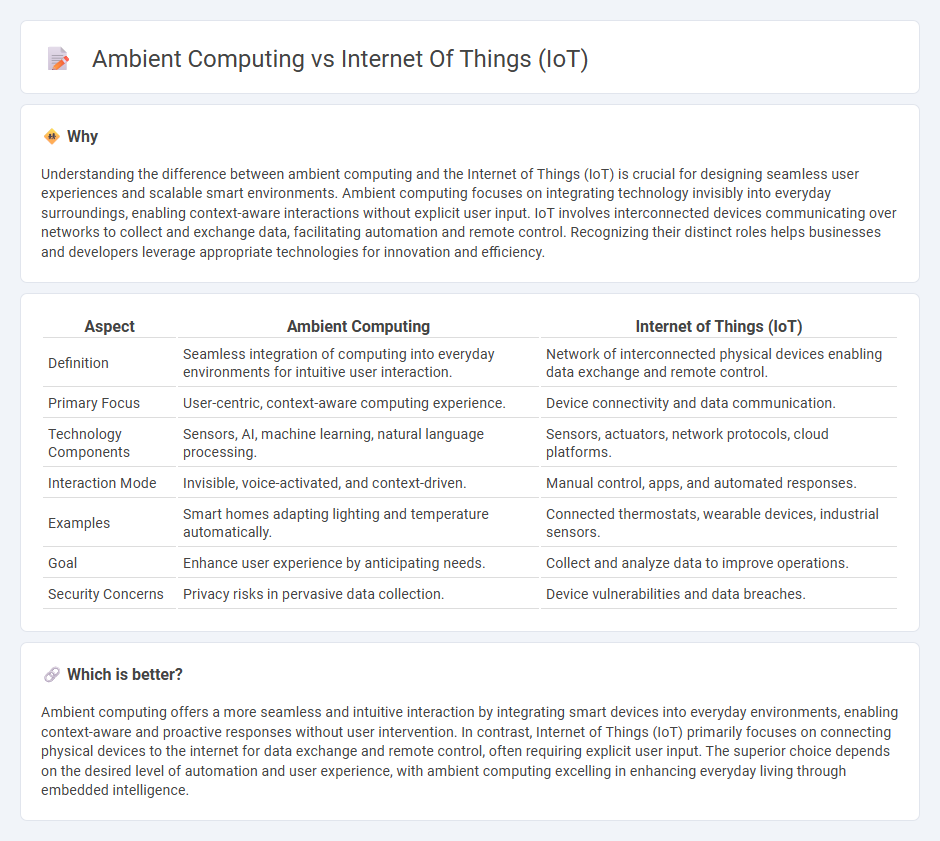
Ambient computing integrates technology seamlessly into everyday environments, enabling devices to interact intelligently without direct human input. In contrast, the Internet of Things (IoT) refers to a network of interconnected devices that collect and exchange data to improve automation and decision-making processes. Explore further to understand how these technologies transform digital experiences.
Why it is important
Understanding the difference between ambient computing and the Internet of Things (IoT) is crucial for designing seamless user experiences and scalable smart environments. Ambient computing focuses on integrating technology invisibly into everyday surroundings, enabling context-aware interactions without explicit user input. IoT involves interconnected devices communicating over networks to collect and exchange data, facilitating automation and remote control. Recognizing their distinct roles helps businesses and developers leverage appropriate technologies for innovation and efficiency.
Comparison Table
| Aspect | Ambient Computing | Internet of Things (IoT) |
|---|---|---|
| Definition | Seamless integration of computing into everyday environments for intuitive user interaction. | Network of interconnected physical devices enabling data exchange and remote control. |
| Primary Focus | User-centric, context-aware computing experience. | Device connectivity and data communication. |
| Technology Components | Sensors, AI, machine learning, natural language processing. | Sensors, actuators, network protocols, cloud platforms. |
| Interaction Mode | Invisible, voice-activated, and context-driven. | Manual control, apps, and automated responses. |
| Examples | Smart homes adapting lighting and temperature automatically. | Connected thermostats, wearable devices, industrial sensors. |
| Goal | Enhance user experience by anticipating needs. | Collect and analyze data to improve operations. |
| Security Concerns | Privacy risks in pervasive data collection. | Device vulnerabilities and data breaches. |
Which is better?
Ambient computing offers a more seamless and intuitive interaction by integrating smart devices into everyday environments, enabling context-aware and proactive responses without user intervention. In contrast, Internet of Things (IoT) primarily focuses on connecting physical devices to the internet for data exchange and remote control, often requiring explicit user input. The superior choice depends on the desired level of automation and user experience, with ambient computing excelling in enhancing everyday living through embedded intelligence.
Connection
Ambient computing integrates IoT by embedding smart devices and sensors throughout environments to enable seamless, context-aware interactions. IoT provides the connectivity and data exchange necessary for ambient systems to anticipate user needs and automate tasks efficiently. This synergy drives the evolution of intelligent environments, enhancing user experience through real-time data analysis and adaptive responses.
Key Terms
Connectivity
Internet of Things (IoT) emphasizes the interconnection of physical devices through the internet, enabling seamless data exchange and remote control across diverse applications such as smart homes, healthcare, and industrial automation. Ambient computing extends this concept by creating an environment where computational processes and connectivity are embedded unobtrusively in everyday surroundings, fostering intuitive, context-aware interactions without direct user input. Explore the nuances between IoT and ambient computing connectivity to enhance your understanding of next-generation smart technology ecosystems.
Context-awareness
Internet of Things (IoT) integrates interconnected devices collecting and sharing data, while ambient computing emphasizes seamless context-aware interactions without direct user input. Ambient computing leverages IoT data to create environments that adapt intelligently to user presence, preferences, and activities. Explore deeper insights into how context-awareness transforms user experiences through ambient computing and IoT integration.
Pervasive integration
Internet of Things (IoT) involves interconnecting devices to collect and exchange data, enabling smart environments, while ambient computing emphasizes seamless, context-aware interaction between users and technology embedded into everyday surroundings. Pervasive integration in IoT focuses on connectivity and data flow across diverse devices, whereas ambient computing prioritizes intuitive, unobtrusive user experiences through natural interfaces and AI-driven responsiveness. Explore how these technologies converge to transform digital ecosystems and enhance human-computer interaction.
Source and External Links
What is the Internet of Things (IoT)? - The Internet of Things (IoT) is a network of physical devices embedded with sensors, software, and connectivity that allows them to collect and share data, enabling smart devices to communicate autonomously across industries like manufacturing and healthcare.
What Is the Internet of Things? - IoT is the network of physical objects embedded with sensors and software, connecting and exchanging data via the internet, enabling seamless interaction between people, processes, and things, with applications including industrial automation known as IIoT or Industry 4.0.
What is IoT? - Internet of Things Explained - IoT refers to the system of connected devices worldwide that use sensors and the internet to gather and exchange data smartly, driven by advances in low-cost computing and telecommunications, integrating everyday objects into the digital ecosystem.
 dowidth.com
dowidth.com